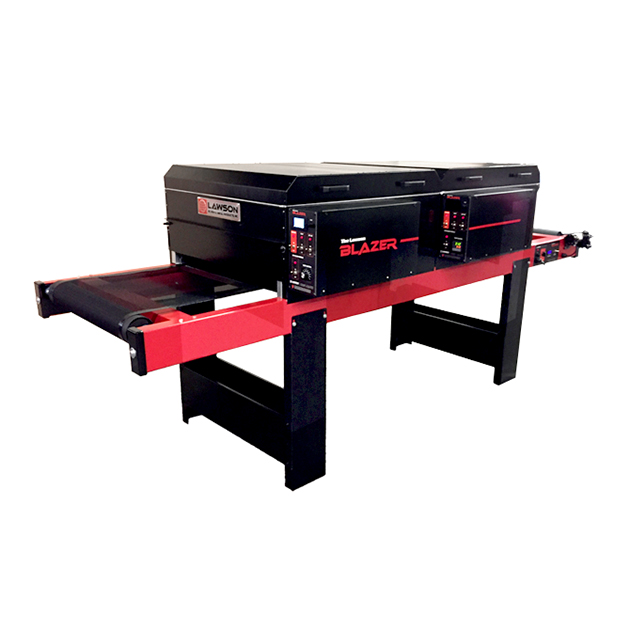Depending on your screen-printing production and business goals, there are a lot of different conveyor dryer options out there. Since a dryer is often one of the largest investments a shop makes, it is important to analyze all of your choices.
As is often the case, there is not a good one size fits all approach. The ideal conveyor dryer for one shop may not be right for another. Understanding your shop’s needs helps determine the right dryer for you.
The first essential choice is how to power your screen printing dryer – either gas or electric. Gas conveyor dryers are one of the best options if you are printing with multiple types of ink, including plastisol, water-based and DTG. Most gas dryers are big and designed for large production shops, with an overall average length starting around 20 feet. However, there are “gas express” options available in a smaller footprint.
Gas dryers heat the oven chamber through the convection process. This is considered a “gentler” heat that is better for T-shirts and other garments compared to electric infrared panels. Another benefit is the energy savings compared to an electric dryer. The main cost of running a gas dryer is simply whatever you pay the utility company for natural gas. Costs varies depending on what part of the United States you are in, but generally speaking, natural gas rates are cheaper than electricity rates.
The alternative to gas powered is an electric dryer. The most popular type of electric dryer uses infrared panels, known as I.R. panels, for heat. Instead of heating a chamber or oven (like a gas dryer), electric I.R. dryers heat the object directly. The I.R. panels focus heat towards the T-shirt, hoodie or other garment passing beneath them. For screen printers, this helps to quickly bring plastisol ink up to the proper curing temperature.
A critical element of electric dryers that often gets ignored is air circulation. Unlike gas conveyor dryers, electric dryers do not need to have airflow for operation. However, circulating air is a key for success, especially when printing on dri-fit, polyester or other heat sensitive fabric. Good air movement helps prevent and minimize garment scorching.
Once you’ve decided whether you want a gas or electric dryer, there are a number of other features to consider.
Unlike plastisol inks, which cure at about 320°F, water-based and DTG inks cure from the removal of moisture. The only way to quickly and properly cure water-based and DTG inks is with a dryer that has a significant amount of air flow, as measured through CFM (cubic feet per minute). A higher CFM rating enables quicker, more efficient curing times. The most effective dryers for DTG and water-based curing have a CFM starting around 1,500.
A conveyor dryer’s size, both in terms of belt width and length, directly relates to production rates. One way to figure out the size of the dryer you need is to calculate your production rates in terms of printing averages and production peaks. Could a potential new dryer handle production peaks? If not, it means your press operator(s) might be waiting to put a shirt on the belt. At a minimum, your conveyor dryer should be able to handle an average day. However, printers seeking growth and more business should think beyond these daily screen print and DTG printing averages.
Often, screen and DTG printers are worried about outgrowing their dryers. Look for manufacturing companies that offer Trade-In/Trade-Up programs. These programs help minimize concerns about outgrowing your dryer and can also be a sign of providing ongoing support.
Keeping these basic principles in mind when it comes to choosing the right dryer will ensure you get a dryer that is right for you.





